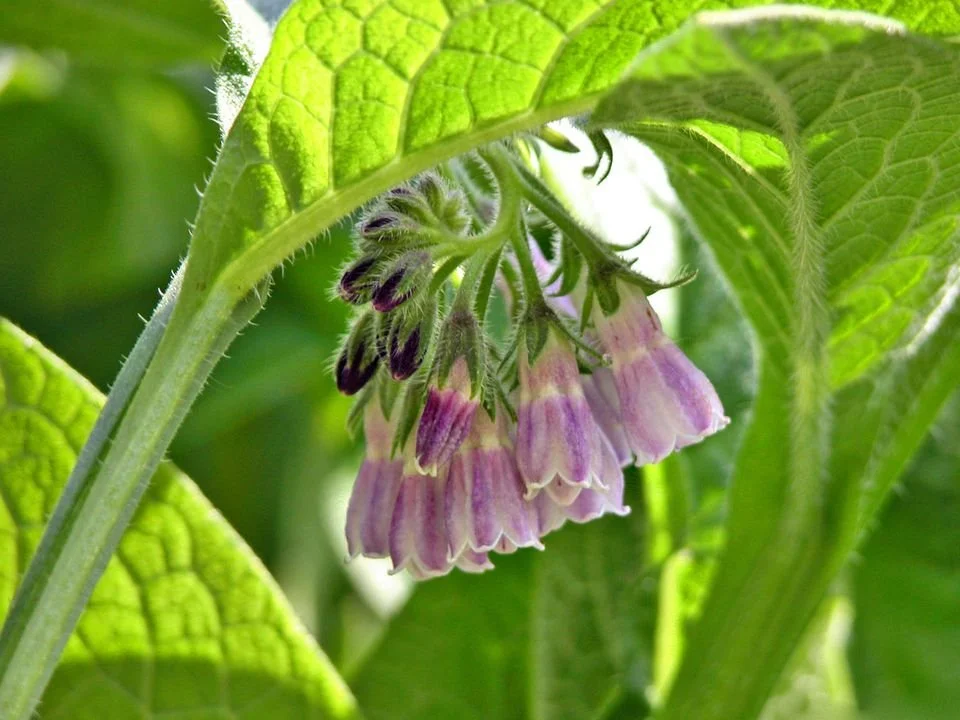Uses for Comfrey; body and garden
Comfrey is something I have recently discovered. I sort of knew about it through reading articles, but nothing teaches better than getting your hands in the dirt and watching something grow from seedling to flower.
I am still learning about being a green thumb, and I am making mistakes as I go. A mistake I made turned out to be a really important observation.
I wanted more flowers in my garden, and the gardens of home have fox glove, daffodils, tulips, roses and all kinds of cottage flowers. I planted some foxglove in the garden. I knew it was poisonous but would keep an eye on the chickens - they don’t pay any attention to it (plenty other morsels to glutton themselves as free range hens).
The foxglove was planted next to the comfry seedlings, not for any reason, I just had a spot for them next to the comfry. Within a few weeks as the warm weather kicked in and both the comfry and foxglove grew larger, I noticed they looked -VERY SIMILAR- to each other. In fact, it was hard to tell the difference unless you pay attention to the subtle details of the leave edges and the vein patterns in the leaves. Foxglove only blooms in the 2nd year from planting, so just looking at leaves, you wouldn’t know.
The reason why this observation is so important is because if ingested, foxglove is highly toxic and you can end up in severe condition quickly.
My garden mentor, in fact, shared a story about his son who was foraging in Germany. He picked what he thought was comfry for a tea, but in fact it was foxglove! He wound up in hospital very ill, he could have died.
So mistakes are very useful lessons and garden observation is something I practice a few times per day.
Part of the observation practice is to look around and see what is growing, how it is growing, what needs support, what needs to be weeded or if there are pests moving in. By daily observation, you can usually get on top of an issue before it becomes out of hand.
This observation process lends itself to research and I learned that planting comfry in the veggie bed (I did an edging, what permaculture articles have mentioned to do) actually creates a pretty decent problem down the track.
Comfrey is wonderful, with healing properties for humans as well as plants, but it spreads quickly and if you are digging around those plants and chop any of the root, it can sprout another plant from the root.
So, planting comfry along the edge of a veggie garden would mean you are likely digging up and chopping the roots unknowingly and before you know it, the comfry is out of control.
I came across an article about planting it at the base of fruit trees instead. You generally don’t dig around fruit trees, so therefore you won’t disturb the roots and risk the plants spreading too far. An added bonus is that the tap root is so long and goes deep, accessing minerals deep under the soil - when comfry goes into dormancy in winter and dies back, those minerals are a boost for your fruit trees.
Another issue with comfry is that it may contain harmful amounts of pyrrolizidine alkaloids, people with liver issues are warned not to ingest it and warnings exist to encourage people to avoid eating this plant. That said, a lot of my older herbal books praise comfry as a healing herb for tea and I have come across discussions online where people had it as kids as a green tonic with pineapple juice during cold and flu season.
It is likely something to do with moderation, science just doesn’t know what that moderation is yet.
Where it is very beneficial and how I use it is in the garden! It is a forever compost. Because it is a perenial plant, it comes back year after year and the leaves can be picked and chopped for a green mulch, added to compost, made into a compost tea and foliar spray for Biodynamic applications.
It is easy to propagate so I will never have to buy another plant.
An ancient remedy used to call Comfrey “bone-knit” because it supports tissue healing through Allantoin, a substance that stimulates cell production and thus helps wound healing. You can massave a salve made from the roots into bruises, inflamed joints, broken or fractured bones, swollen tendons or soft tissues. It is safe to use externally on livestock and humans. It is worth having a comfrey salve in your herbal first aid kit!

